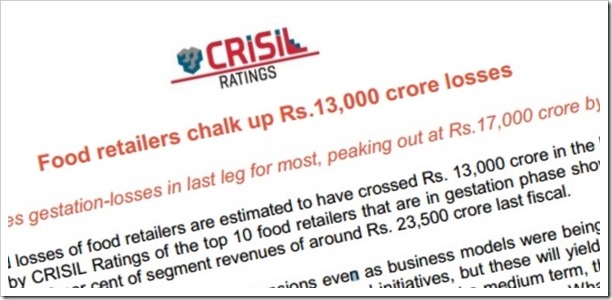Credit Rating Information Services of India Limited (CRISIL) has just conducted an analysis of the top 10 food retailers of India and found out a chilling fact: All of them are incurring heavy losses. During 2013, these top food retailers of India accumulated combined loss of Rs 13,000 crore or $2.2 billion owning to various factors.
In the overall organized retail market, these top 10 food retailers accounted for revenues of Rs 23,500 crore, which is roughly 40% of the organized retail market.

The food retailers which CRISIL analyzed are: Max Hypermarket, Hypercity Retail, Aditya Birla Retail, Metro Cash and Carry India, Trent Hypermarket, Reliance Fresh, Heritage Fresh, Spencer’s Retail, Bharti Retail and WalMart India.
Only two retailers: Future Value Retail Ltd (Big Bazaar and Food Bazaar), and Avenue Supermarts Ltd (D-Mart) have been able to reduce losses and are actually looking forward to profits as well.
Crisil Ratings president Ramraj Pai observed, “These losses reflect the challenges in the food and grocery retailing vertical. Compared with other formats, food retailing is a very local business where optimal supply chains are critical to lower costs.”
No other industry including apparel, consumer durables or footwear has ever witnessed such large scale losses. Indian retail market is estimated at Rs 25.3 trillion, out of which food and grocery account for 69% of the overall transactions.
Organized retail, though at a nascent stage, accounts for only 2.3% of the overall food and grocery sales in India. The report estimates that the loss will swell to Rs 17,000 crore by 2017.
Main reason for losses: Kirana Stores
The report by CRISIL clearly highlights the fact that kirana stores present in each and every corner of the country are the primary reasons for this huge losses incurred by various food retailers. Food and grocery items are very much dependent on the local tastes and preferences, and a manager sitting inside the AC cubicle of a “food super market” would find it really difficult to catch the pulse of the local public.
Additionally, the food items need to be fresh before selling, which takes up considerable amount of infrastructural expenses. And another fact is that margins on food items are the lowest. The modern day Kirana stores are actively modifying themselves so as to suit the needs of the modern customers, thereby increasing competition for the organized food retailers. And now, there are ecommerce portals which are adding up competition as well.
Interestingly, it is the food and grocery items which accounts for more than 50% of revenues of global retailers such as Walmart and Tesco.
Ramraj Pai adds, “Compared with other formats, food retailing is a very local business where optimal supply chains are critical to lower costs. Players, therefore, need a lot of time and investment to perfect the model and positioning (such as the location, store size, choice of products and development of private labels), and to scale up to achieve critical mass.”
Food Retailers Fight Back
CRISIL, in its analysis, observes that food retailers are actually fighting back as they have introduced several measures to ramp up their operations.
Some of the steps which are being actively implemented:
- Moving out of non-profitable categories
- Cutting down on store sizes
- Closing non-performing stores
- Slowing down expansion
- Increased focus on branded ; private brands
Promoters and investors who have backed these food retailers are aware that this industry will take time to reap profits, and they are playing it really cool.
As per the report, promoters and investors have pooled in almost Rs 19,000 crore (as of March 31, 2014) as investment in these loss making retail stores, and will continue to do so till 2017, when they are ‘expected’ to break even.

[…] comes out at an interesting time, when Food retailers are bleeding big time as they accumulated Rs 13,000 loss in 2013; and Reliance Retail have posted their first profit after 7 years and $1 billion […]